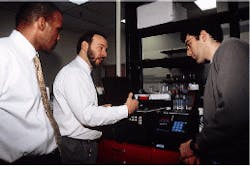Photonics Center bridges gap between academia and industry
DONALD C. FRASER
On June 13, 1997, two US senators and the mayor of Boston came to the campus of Boston University (Boston, MA) to celebrate the opening of a nine-story, 235,000-sq ft photonics building. Beyond its academic significance, the $80 million state-of-the-art facility demonstrates the university’s continuing commitment to a three-year-old collaboration with industry that is already producing results.
On the academic side, laboratories and classrooms in the new photonics building will support the university’s diverse interdisciplinary research and educational programs in the burgeoning field of photonics. On the industrial side, the building will provide a new home for Boston University`s three-year-old Photonics Center. Thus, companies that form product-development partnerships with the center will have access to the same laboratories, classrooms, and expertise of the university as the academic faculty. In addition, the center provides incubator space and other services for startup firms.
Unlike most university-based programs, the fundamental mission of the Photonics Center is to develop new products. Our underlying philosophy calls for involving students and faculty directly with industry in the process of developing and commercializing products. We believe that this direct involvement strengthens our educational and research programs in everything from engineering to management, while allowing us to focus the university’s resources in a way that assists companies and stimulates the economy.
Last summer, for example, we began working with Mosaic Technologies (Boston, MA)—a biotechnology startup—to develop a sensitive, rapid, and cost-effective method of screening blood for viruses. The company came to the Photonics Center for help in transferring its DNA testing method to a fiberoptic-based instrument (see Laser Focus World, Feb. 1997, p. 34). Working with Mosaic, the Center developed an inexpensive, yet sensitive, fiberoptic fluorometer for use with the company’s amplification technology (see photo). The resulting system has the potential to detect several different viruses in a single blood sample and to simultaneously test multiple blood samples—all for the same cost and effort as a single viral test using present technology.
Boston Advanced Technologies Inc. (Marlboro, MA) moved beyond the incubator in the fall of 1995 and is already reaping the benefits of partnership with the Photonics Center. The company developed a detector that identifies the presence of red dye in diesel fuel. Internal Revenue Service agents are using the portable 8 × 6 × 4-in. unit to distinguish tax-exempt high-sulfur fuel from its taxable low-sulfur counterpart. A similar device can detect infinitesimal amounts of dye that may contaminate jet fuels and clog nozzles in sensitive jet engines.
Source of development ideas varies
Product ideas also come from within the center. Three years ago, faculty member Theodore Moustakas demonstrated the first bright, long-life, room-temperature, blue LED in the USA. Recently, he developed solid-state technology for a system that detects ultraviolet emissions. The system can detect heat-seeking missiles even against a background of bright sunlight. It can also be used to create highly efficient combustion-monitoring systems for industrial ovens. A spin-off company, Blue Light (Boston, MA), is developing related technologies and applications and is already working in partnership with the country’s largest defense contractor, Lockheed Martin (Bethesda, MD).
Another member of the photonics faculty, Thomas Bifano, developed a manufacturing module that produces optical disk stampers using an ultraclean, precision ion machining process. The module creates a moldable disk stamper in less than 10 min—cutting the fabrication time by more than 80% while reducing manufacturing costs by more than 50%. The module—which was introduced to the industry last June at the REPLItech International meeting (San Jose, CA)—completely eliminates wet chemistry from the process and produces no heavy metal waste.
To date, the Photonics Center has forged about 12 business partnerships with companies large and small. Each agreement is tailor-made, based upon common business arrangements. The partnerships have included royalty agreements, equity partnerships, and joint ventures. In another type of partnership, the center recently established a relationship with Photonics Private Capital Fund, a venture-capital fund that provides investment capital for photonics companies at all stages of growth, including start-ups.
Overall, we believe we are building a new model for university-industry relations in which everyone benefits substantially. Faculty members learn more about practical problems in their field. Students get better preparation for the world they will face as professionals. Companies benefit by reducing the risk and investment required to develop new products. The region benefits because existing companies grow and new ones form. Society benefits from the commercialization of new technology.
Boost to local economy
Recognizing the potential of this approach, Senator Edward Kennedy (D-MA) and Senator Daniel Inouye (D-HI) helped to arrange $16 million in initial federal funding for the photonics building. Boston University raised the remaining $64 million. The senators appeared at the opening, along with Mayor Thomas Menino of Boston, who endorsed the importance of the center to the local economy.
The Photonics Center is organized to provide support at every stage of product development—from idea to prototype to market. The facility is a world-class building with a floating foundation that eliminates vibration, water ionization and high-capacity electrical systems, and flexible and functional laboratory space that is fully permitted for special research-related tasks such as handling fuels, monitoring radiation, and discharging chemicals.
With its array of state-of-the-art equipment and access to some of the world’s pre-eminent photonics researchers, the facility stands ready for high-technology research and development work. It builds a vital bridge between academia and industry, dedicated to bringing valuable new products to market.
